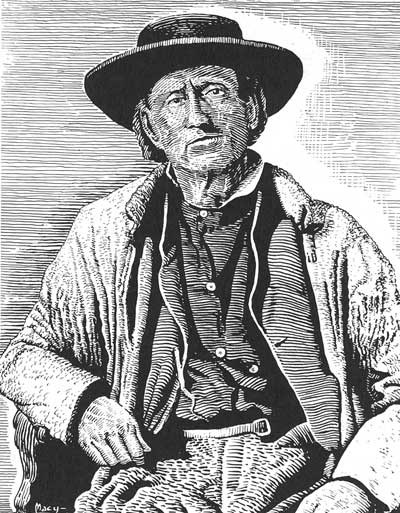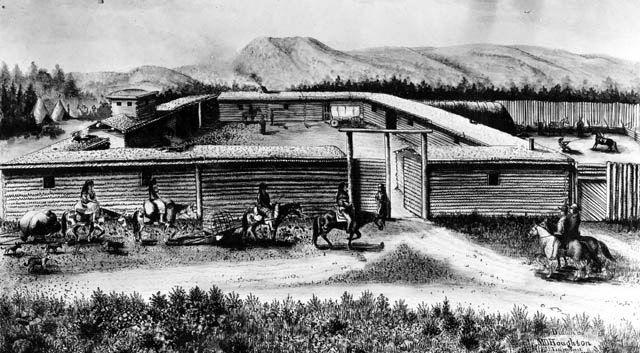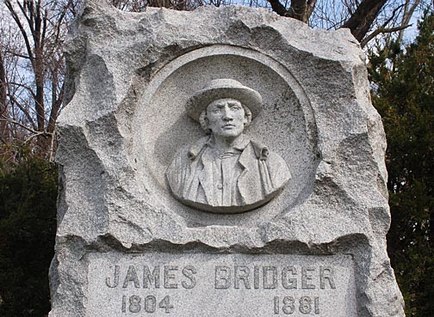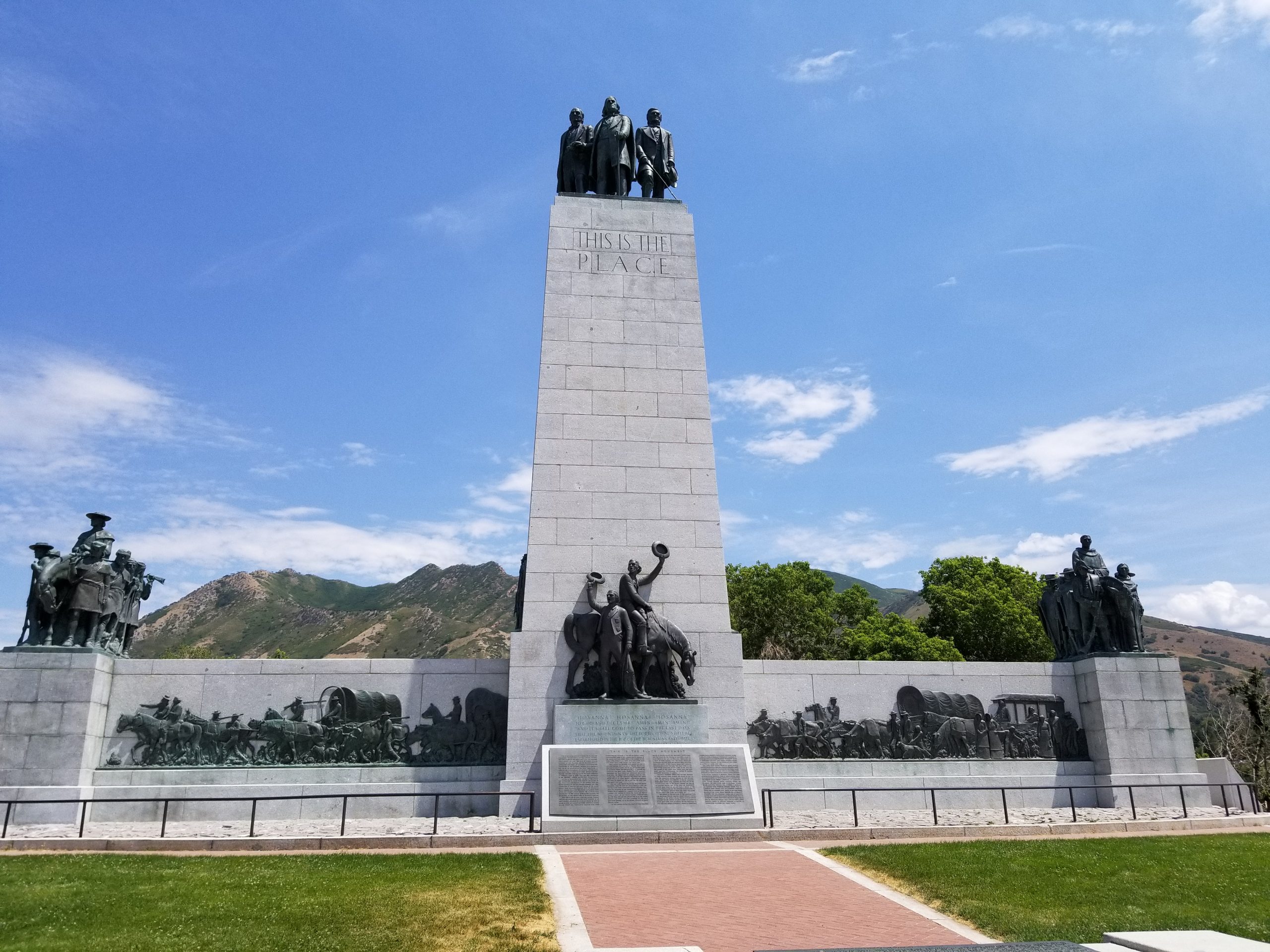Write-up by Mark Trapasso
Placed By: Bear River Chapter of Future Farmers of America and Utah Pioneer Trails and Landmarks Association, No. 10
GPS Coordinates: 41° 38′ 7.44″ N, 112° 7′ 42.24″ W

Historical Marker Text:
Early Western Fur Trapper, Frontiersman, Scout and Guide. To settle a wager among the trappers who were making their first winter rendezvous in Cache Valley, Bridger floated alone in a bull boat down the Bear River to its outlet to determine the river’s course in the late Autumn or early Winter of 1824, thus making the original discovery of Great Salt Lake, but believing he had discovered a salty arm of the Pacific Ocean, he halted at such view points as this en route to reconnoiter.
Extended Research:

James Bridger, better known as Jim Bridger, was born on March 17, 1804 in Richmond Virginia. At the age of 8 Bridger’s father moved his family to a small farm just outside of St. Louis, Missouri. While in Missouri, Jim never received a formal education, but Bridger “apprenticed to a blacksmith, learned to handle boats, and became a good shot and skilled woodsman.”[1] In 1822 he was hired by the Ashley-Henry Fur Trading Company. While he worked for this company, he was crucial to the construction of the first fur trading post along the Yellowstone River. Bridger is also credited as the first Euro-American man to discover the Great Salt Lake. This, though, ignores the Native Americans who inhabited the region long before Bridger’s arrival. In 1776, the Spanish explorers, Dominguez and Escalante, traveled north from New Mexico looking for a more effective trade route from Santa Fe to the West Coast. During this expedition, Escalante kept a detailed journal of his voyage. In this journal he states, “the Timpanois assured us that anyone who wet some part of the body with them immediately felt a lot of itching in the part moistened.”[2] This entry proves that long before Bridger ever floated down Bear River, there were previous inhabitants of the area that were familiar with the Great Salt Lake.
There is more to Bridger’s story than just floating down a river; he had a very complex relationship with Utah and its Mormon settlers. On June 28, 1847, Brigham Young and Jim Bridger met for the first time at Little Sandy River. Young described Bridger a “pioneer, hunter, trapper and trader, 43 years old, relatively short in stature but with a thick neck.”[3] During their meeting, Bridger mapped out and gave Brigham Young a detailed description of the Wasatch Front. Bridger was optimistic about the Great Salt Lake area sustaining a large population, but was skeptical if the weather was going to be too harsh for crops.

By the end of 1843, Bridger had built and established a very well known trading post located on Black’s Fork of the Green River. This trading post was known as Fort Bridger, and later served as a military outpost. In 1853, the relationship between the Mormon settlers and Jim Bridger started to boil over. Bridger was accused by Mormon leaders of illegal trading with Indians to profit himself, and potentially put the Mormons in danger with the sale of weapons and ammunition. Due to this accusation, Bridger’s trading rights were revoked and a warrant was issued for his arrest. Before anyone could reach Bridger, he had fled.[4] When he returned in 1855, Bridger sold his fort to the Mormons for 8,000 dollars. During the Utah war, the Mormons knew that this could be a valuable resource for the U.S., so they set fire to the fort before deserting it. Once the militia had arrived, they spent a miserable winter there with little to no supplies.

After Bridger’s days of exploration and fur trading were over he took his family to a small farm in Westport Missouri. With no remaining contact between the Mormon settlers or Brigham Young, he lived the rest of his days in peace surrounded by his family. James Bridger died in Missouri at the age of 77 on July 17, 1881.
[1] “Jim Bridger Born.” History.com. A&E Television Networks, November 16, 2009. https://www.history.com/this-day-in-history/jim-bridger-born.
[2] Sanchez, Joseph P. Explorers, Traders and Slavers : Forging the Old Spanish Trail, 1678-1850. Salt Lake City: University of Utah Press, 1997. Accessed April 24, 2020. ProQuest Ebook Central.
[3] Bennett, Richard E. We’ll Find the Place : The Mormon Exodus, 1846-1848. 1997
[4] “BRIDGER, JAMES.” Utah History Encyclopedia. Accessed April 3, 2020. https://www.uen.org/utah_history_encyclopedia/b/BRIDGER_JAMES.shtml.
For Further Reference:
Primary Sources:
“Major Jim Bridger, the First Great Utahn.” Goodwin’s Weekly, 4 July 1908. Utah Digital Newspapers. Accessed April 3, 2020. https://newspapers.lib.utah.edu/details?id=3497493&q=fort+bridger&sort=rel&page=2.
“Jim Bridger, ‘Covered Wagon’ Hero, Brave, Honest and True Frontiersman.” Salt Lake Telegram, 27 January 1924. Utah Digital Newspapers. Accessed April 3, 2020. https://newspapers.lib.utah.edu/details?id=15435975&q=Jim+Bridger,+‘Covered+Wagon’+Hero,+Brave,+Honest+and+True+Frontiersman.&sort=rel.
Secondary Sources:
Bagley, Will. “Fort Bridger.” WyoHistory.org, November 8, 2014. https://www.wyohistory.org/encyclopedia/fort-bridger.
Chan, Amy. “A Bridge Too Far.” HistoryNet. HistoryNet, July 17, 2019. https://www.historynet.com/a-bridger-too-far.htm.
Chiaventone, Fredrick J. “Jim Bridger.” Cowboys and Indians Magazine, August 2015.
Foster, Robert L. 2012. “A Bridger Too Far.” Wild West 25 (2): 28–35. http://search.ebscohost.com/login.aspx?direct=true&db=asn&AN=76320993&site=ehost-live.
Mays, Kenneth. “Picturing History: Jim Bridger and the Little Sandy Crossing.” Deseret News, September 11, 2019. https://www.deseret.com/2019/9/11/20857787/picturing-history-jim-bridger-brigham-young-and-the-little-sandy-crossing-wyoming.
Sanchez, Joseph P. Explorers, Traders and Slavers : Forging the Old Spanish Trail, 1678-1850. Salt Lake City: University of Utah Press, 1997. Accessed April 24, 2020. ProQuest Ebook Central.
“BRIDGER, JAMES.” Utah History Encyclopedia. Accessed April 3, 2020. https://www.uen.org/utah_history_encyclopedia/b/BRIDGER_JAMES.shtml.
“Jim Bridger Born.” History.com. A&E Television Networks, November 16, 2009. https://www.history.com/this-day-in-history/jim-bridger-born.
